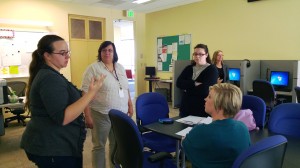By Kirsten Mahon/tr news editor
Some TCC students are a part of what they describe as Deaf Culture. Sarah Couch and Wendi Yoder are American Sign Language students on TR Campus. Neither student is deaf, but both have come to enjoy the silent community.
Currently on TR Campus, four teachers are deaf. Sign Language instructor Cheryl Sohns is deaf. This is her first year teaching.
“When I started [teaching], it was overwhelming because I’m not used to grading all the papers or preparing the lesson plans,” Sohns said. “Now I’m pretty comfortable.”
Sohns said her reasons for wanting to teach have changed since she began. She was a housewife for 20 years, and when she and her son were talking about his going to college, Sohns decided she would go too.
“In the end, I finished school, and he didn’t,” she said, laughing.

She said when she was younger and taking care of her children, she didn’t want to have to split her time between school and home.
“I decided I wanted to teach my language,” she said.
American Sign Language is Sohns’ first language. Her parents lost their hearing when they became ill, and Sohns was born deaf. She said she didn’t realize she was deaf until she about 10 years old.
“I went to a deaf school, and everything around me was in sign. It was ASL,” she said. “I was about 7 or 8 when my parents went to my neighbors to use the phone, and I realized my neighbors were hearing, but it never had an impact on me. Everybody around me always signed.”
A difference exists between people who classify themselves as deaf and those who have joined the Deaf Culture, Yoder said. Normally, a capitalized “D” means the person isn’t just deaf but has become immersed in a lifestyle different from the average hearing person.
Yoder said some deaf people may have never known other people with hearing impairments and were never introduced to the culture.
“One of the differences is that most — not all, but most — of the hearing culture sees deafness as a disability, something that’s broken or the people are broken,” Couch said. “In the Deaf Culture, deafness is not a handicap or a disability. It’s just who they are.”
Couch said mannerisms are different when everyone in a conversation can speak sign language.
“If you know sign language, using your voice is rude unless you sign with it,” she said.
Six percent of communication in sign language is understood by spoken word. The rest is by body language and sign, Couch said. It’s near impossible to read lips to the same extent of speaking in signs.
“But just because they can’t hear doesn’t mean they don’t make noises,” she said.
Learning sign language has become a large part of Couch’s and Yoder’s lives. Yoder regularly visits Heritage Square, an assisted-living home for people with vision and/or hearing impairments in Fort Worth. She is fluent in ASL and interprets for TR students. Couch is currently the events coordinator of the ASL Club on TR and is studying to become a teacher for children with hearing impairments.
“I love the Deaf Culture,” Yoder said. “They’re really neat people.”
Compared to the lifestyles of the hearing, Yoder said people in the Deaf Culture tend to have a strong sense of community, do more things together and are extremely positive.
“The Deaf Culture is strong and connected,” Yoder said. “But it is unheard.”


























